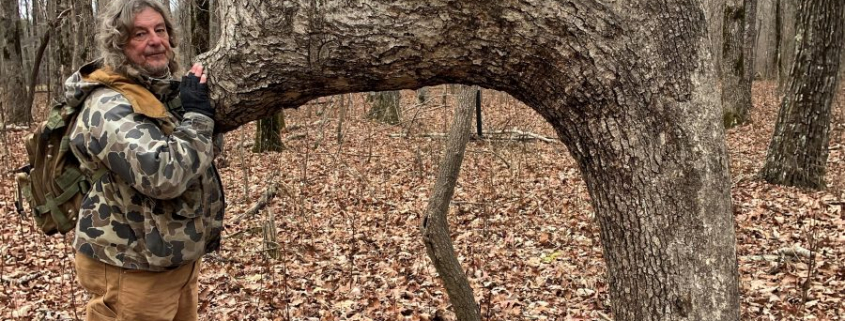Tree Form Curiosities Mid-December 2020 at Monte Sano State Park
December 15, 2020, I hiked several trails at Monte Sano State Park with two naturalist friends, Mike Ezell and Jesse Akozbek. We sought whatever Nature might reveal to us as we trekked in the forest examining everything natural that caught our eye. That’s me below with a 34-inch diameter yellow poplar (Liriodendron tulipifera) in the remarkable cove forest along the Arthur Wells Memorial Trail, one of my favorite haunts at the Park. No tree form oddities with this magnificent specimen! We also explored intersecting sections of the Sinks and Keith Trails.
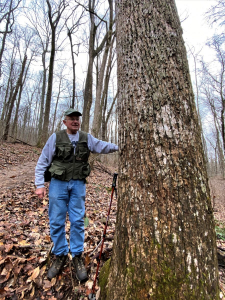
Returning to the new Bikers Pavilion, we spent several hours circuiting the South Plateau and Fire Tower Trails, enjoying the flat and smooth surface. Rather than present a sequential catalog of what we found of interest, I give you some of the tree form oddities and curiosities we encountered, each one with a compelling story.
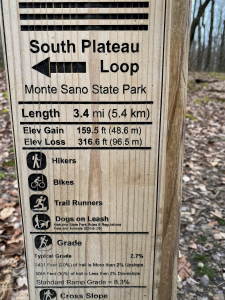
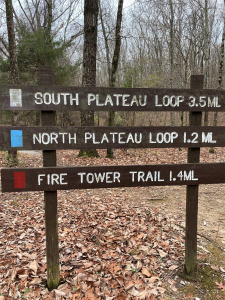
Decades ago this white oak (Quercus alba) suffered a blow (falling large branch or tree) that bent and nearly broke it to 90-degrees about six feet above the ground. Mike is leaning against what was then the bent-over trunk. He’s holding at the point where the damaged stem broke clean or suffered damage sufficient to encourage a dormant bud to take over the terminal growth, sending a shoot vertical, now reaching into the main canopy. We are left with a zig at five feet, a four-foot horizontal zag, and a re-zig to vertical (the terms are my own; I do not recall any formal forestry words of description!). I have heard fellow woods explorers refer to such trees as Indian Marker Trees, suggesting that Native Americans long ago bent the then-sapling to direct others to something of importance. However, based upon land use history and my own experience, I peg this stand at roughly 75-95 years old. The callousing stub Mike is holding was probably no more than four inches in diameter at the time of the causal incident, leading me to conclude that the injury occurred no more than 50 years ago. Also, consider that in 1970 (50 years ago) there had been no trail-blazing Indians hunting and gathering on this mountain for more than a century.
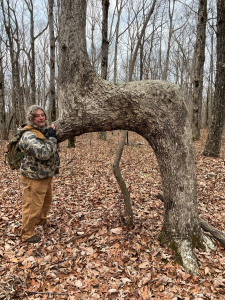
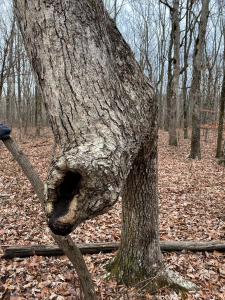
Indian Marker Tree makes a nice story, but Nature tells her own tales. Trees falling on other trees is routine. Those crushed, in full or partially, have honed the craft of recovering from injury. This then young white oak was genetically hard-wired to respond, recover, and reach reproductive age. The two photos below complete the 360-degree view.
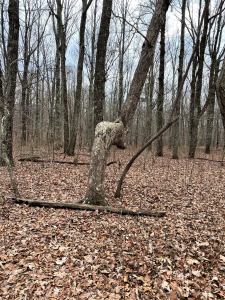
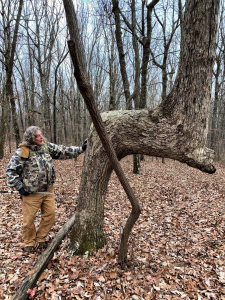
I cannot speculate on what agent created this grotesque protuberance 20 feet up the trunk of a white oak. An old injury? Branch stubs from many years ago still callousing over long after the wound had healed? Antlered branches tufting atop the growth trigger my impulse to find a face, identify a creature, or offer a name.

Perhaps with the inspiration of a rum-fortified New Years Eve eggnog, I could discern the two eyes of the long-necked creature facing down (below left)… or the eyes and snout of the dog-face above it (below right). I suppose no future-naturalist youngster tires of seeing shapes and stories with summer cumulus. I continue the cloud-fascination with tree form curiosities well into the youth of my late 60s!
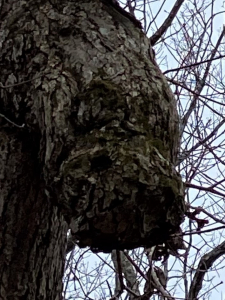
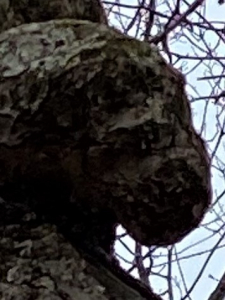
It’s funny how perspective alters our perception of these tree form oddities. I photographed this same peculiar growth from 180-degrees. The result is as different as night and day. Because I do not apply any kind of age-appropriate warnings or cautions to my Posts, I offer this positionally-adjusted image without comment. I leave any interpretation to the discerning, mature reader.
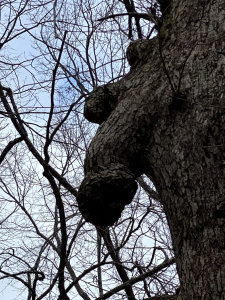
Okay, let’s quickly move to the next image lest I offend anyone… or embarrass myself even more! This eight-inch diameter sourwood (Oxydendrum arboreum), not long dead, suffered a blow years ago that bent it 180-degrees. Persevering, the tree responded by sending a shoot skyward. It fought a valiant battle, its conducting tissue maintaining some level of flow between crown and roots. I’ll term this a pump-handle tree, resembling its moniker… and continuing for years after injury to pump water and nutrients up and bring manufactured carbohydrates down to its roots.
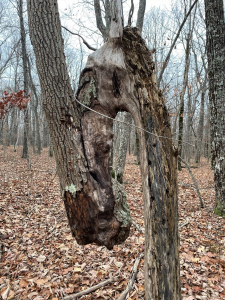
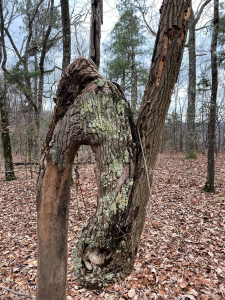
This corkscrew loblolly pine suffered a significant physical insult long ago, breaking its terminal stem and transferring the vertical growth to the side branch on our left. The damaged branch on our right managed to survive… corkscrewing its way upward and outward. Importantly, the tree’s hard wiring enabled it to respond and live competitively into the cone-producing years with its head still in the main canopy.
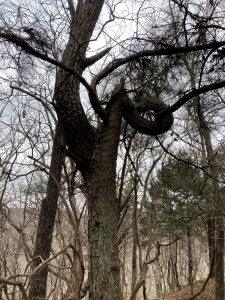
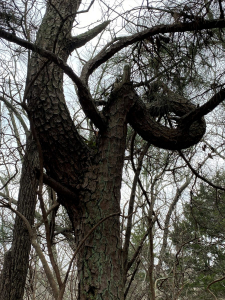
I have often said in these Posts that I have never had a truly original thought. Others before me noticed and recorded observations and conclusions that I have laboriously rediscovered. Five hundred years ago Leonardo da Vinci commented on Nature’s ways and her own laws:
Human subtlety will never devise an invention more beautiful, more simple or more direct than does nature because in her inventions nothing is lacking, and nothing is superfluous.
There is no result in nature without a cause; understand the cause and you will have no need of the experiment.
Nature is the source of all true knowledge. She has her own logic, her own laws, she has no effect without cause nor invention without necessity.
Nature never breaks her own laws.
Perhaps da Vinci had pondered tree form oddities and curiosities?
Not all unusual tree shapes derive from response to injury. Some species find competitive advantage in growing other than vertically. Farkleberry (Vaccinium aboreum) is the only tree-form member of the blueberry genus. Tree form stretches the term. I view farkleberry as a taller bush, its branches layered and contorted, gnarled and twisting. I conjecture that its comparative advantage as an understory inhabitant is its ability to capture as much of the crown-penetrating sun flecks as possible. And to live long and prosper without direct full sun. It has no need to grow scores of feet tall or achieve a girth measured in feet. Like all living organisms, it needs only enough to assure a next generation, to sustain the species.
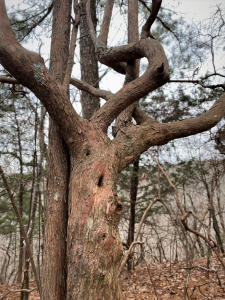
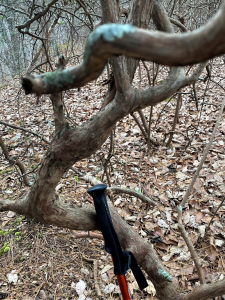
Farkleberry (also called sparkleberry) knows not to live beyond its means. Will we humans realize before its too late the wisdom inherent in this tree-form blueberry?
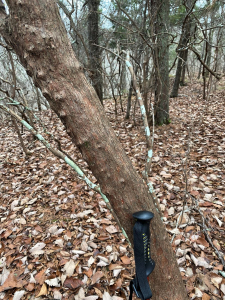
Will we open our eyes to Nature’s wisdom? Leonardo’s revelation is worthy of repeat:
Nature is the source of all true knowledge. She has her own logic, her own laws, she has no effect without cause nor invention without necessity.
Alabama State Parks Foundation
I’ll remind you that I serve on the Alabama State Parks Foundation Board, in part because of my love of Nature and in recognition for my writing many prior Posts about visiting and experiencing the Parks. I urge you to take a look at the Foundation website and consider ways you might help steward these magical places: https://asparksfoundation.org/ Perhaps you might think about supporting the Parks System education and interpretation imperative: https://asparksfoundation.org/give-today#a444d6c6-371b-47a2-97da-dd15a5b9da76
The Foundation exists for the sole purpose of providing incremental operating and capital support for enhancing our State parks… and your enjoyment of them.
Thoughts and Reflections
Leonardo da Vinci learned lessons from Nature applicable to us 500 years hence:
- Nature is the source of all true knowledge
- She has her own logic, her own laws
- She has no effect without cause nor invention without necessity
Inhale and absorb Nature’s elixir. May Nature Inspire, Inform, and Reward you!
Note: All blog post images created & photographed by Stephen B. Jones unless otherwise noted. Please circulate images with photo credit: “©2021 Steve Jones, Great Blue Heron LLC. All Rights Reserved.”
Another Note: If you came to this post via a Facebook posting or by an another route, please sign up now (no cost… no obligation) to receive my Blog Post email alerts: http://eepurl.com/cKLJdL
And a Third: I am available for Nature-Inspired Speaking, Writing, and Consulting — contact me at steve.jones.0524@gmail.com
Reminder of my Personal and Professional Purpose, Passion, and Cause
If only more of us viewed our precious environment through the filters I employ. If only my mission and vision could be multiplied untold orders of magnitude:
Mission: Employ writing and speaking to educate, inspire, and enable readers and listeners to understand, appreciate, and enjoy Nature… and accept and practice Earth Stewardship.
Vision:
- People of all ages will pay greater attention to and engage more regularly with Nature… and will accept and practice informed and responsible Earth Stewardship.
- They will see their relationship to our natural world with new eyes… and will understand more clearly their Earth home.
Tagline/Motto: Steve (Great Blue Heron) encourages and seeks a better tomorrow through Nature-Inspired Living!
Steve’s Three Books
I wrote my books Nature Based Leadership (2016), Nature-Inspired Learning and Leading (2017), and Weaned Seals and Snowy Summits: Stories of Passion for Place and Everyday Nature (2019; co-authored with Dr. Jennifer Wilhoit) to encourage all citizens to recognize and appreciate that every lesson for living, learning, serving, and leading is either written indelibly in or is powerfully inspired by Nature.
I began writing books and Posts for several reasons:
- I love hiking and exploring in Nature
- I see images I want to (and do) capture with my trusty iPhone camera
- I enjoy explaining those images — an educator at heart
- I don’t play golf!
- I actually do love writing — it’s the hobby I never needed when my career consumed me
- Judy suggested my writing is in large measure my legacy to our two kids, our five grand kids, and all the unborn generations beyond
- And finally, perhaps my books and Blogs could reach beyond family and touch a few other lives… sow some seeds for the future


All three of my books (Nature Based Leadership; Nature-Inspired Learning and Leading; Weaned Seals and Snowy Summits) present compilations of personal experiences expressing my (and co-author Dr. Wilhoit for Weaned Seals and Snowy Summits) deep passion for Nature. All three books offer observations and reflections on my relationship to the natural world… and the broader implications for society. Order any and all from your local indie bookstore, or find them on IndieBound or other online sources such as Amazon and LifeRich.

